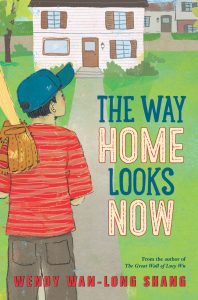 The Way Home Looks Now
The Way Home Looks Now
Written by Wendy Wan-Long Shang
Scholastic Press, 2015, 272 pp.
ISBN-13: 978-0545-60956-2
With a book cover showing a boy with a baseball cap facing a house, many readers might think The Way Home Looks Now would be a piece of contemporary realistic fiction. Set in 1970’s Pittsburgh, the story feels like contemporary fiction rather than historical fiction because of the universal childhood themes around baseball. The book is about a Taiwanese-American family’s growth and resilience after a family loss, all within complex layers of relationship issues in the family and community. The protagonist, Peter Lee, is the family’s second child and is passionate about baseball. (He even completes most of his school projects on baseball topics.) His older brother Nelson is also a great batter and mentor for Peter. Then, Nelson is killed in a car accident.
The author focuses on the drastic changes in home atmosphere after Nelson’s death. When Nelson is a part of Peter’s life, everything is normal in the household. After Nelson’s sudden death, however, Peter’s mom sinks into heavy depression and her busy kitchen nearly stops. Cooking becomes a forgotten ritual. Ba, Peter’s father, doesn’t show his feelings and acts as if nothing has happened. Ba’s response may be understood through a cultural lens, as he is an Asian man who grew up under Confucianism’s influence. Peter’s father is a Taiwanese-born man and his portrayal is similar to typical representations of Asian fathers in the children’s books about Asian-Americans/immigrants. He is inflexible but rule-oriented until he becomes involved with the Little League team. The strict and seemingly rigid Ba transforms as he serves as a coach for the team. Peter also experiences and learns about the unknown sides of Ba. After Ba becomes the coach, the Little League team goes through good days and hard situations. Their efforts to keep the team together help Peter and Ba become more open with each other as well as with the other teammates. Eventually they learn to accept each other despite the significant dilemmas around gender and an initial resistance to making an exception for their team.
The Way Home Looks Now portrays Peter’s childhood through baseball games, schooling, sports, friendship and death. Sensitive social issues such as sexism and micro-aggressions are also embedded in the storyline, as are cultural connections with Peter’s Taiwanese heritage. Wendy Wan-Long Shang’s books portray Chinese- and Taiwanese-American experiences as “cosmopolitan.” Asian characters are portrayed as members of the transnational community with a mixed cultural ethos and cultural practices. Their social generality as citizens of the U.S. is kept as their main membership.
This story invites the audience to think of the subtle social gaze of “otherness” in which Asian characters, regardless of citizenship, are seen as different. In the book, “Oriental” is used as an ethnic identifier by another character who expresses his discomfort towards Ba, whose name and language are different from the “typical American’s.” Martin, a teammate of Peter’s, also expresses this otherness when talking about Ba:
“Baaaaaaawwwwwww?” Martin stretches and exaggerates the sound. “What kind of name is that?”
“It’s Chinese.” I try to sound serious and important, but part of me is wishing I had just said ‘My father’…. It is not alright with Martin.
“Baaaaaaaaaa. How do you know a goat won’t come instead of your dad? How do you say ‘shut up’ in Chinese? Is it ching chang chong?” (p. 111-112).
This book brings up issues around cultural, historical, and critical social awareness: how the nation of Taiwan separated from China and Taiwanese national identity and pride as different from Chinese; how Confucianism partially shapes Ba and his transnational identity; how Japan occupied Taiwan and how the Taiwanese Baseball Team was created under Japanese influence; how baseball has unique cultural differences between the U.S. and Taiwan; how Japan’s national sport is baseball and how Peter is unaware of this fact because he grew up in America, and sexism’s prevalence in 1970s Pittsburgh. Several touches of brief Taiwanese history and cultural ethos are included in authentic ways. Peter’s relatability at times negates his status as an outsider in the U.S., which is of concern. The baseball theme serves as an intercultural bridge between U.S. and Northeast Asian history. For example, through a school project, Peter discovers President Roosevelt’s “Green Light” Letter, encouraging baseball to go on in spite of WWII.
The Way Home Looks Now can be explored through a variety of sub-themes, including sports, death, family relationships, and social gender stereotypes. A Long Pitch Home by Natalie Dias Lorenzi (2016), Under the Red-Blood Sun by Graham Salisbury (2014), Mexican White Boy by Matt de la Peña (2008), Catching the Moon: The Story of A Young Girl’s Baseball Dream by Crystal Hubbard (2009), Keeping Score by Linda Sue Park (2010), and Full Cicada Moon by Marilyn Hilton (2015) would be helpful in drawing intercultural connections with baseball experiences or gender stereotypes and social resistance.
In her author’s note, Shang shares her personal inspiration for writing this book, specifically Taiwan’s years of dominating the Little League World Series. Her Chinese-American parents grew up in Taiwan (then Chinese Taipei) and their experiences supporting the Taiwanese team inspired the global baseball connections in this book. Cultural authenticity is not a concern with this book in terms of representing Taiwanese-American culture and baseball as two important cultural concepts. The author’s note provides insightful story background along with baseball pick-up game ideas.
Yoo Kyung Sung, University of New Mexico, Albuquerque NM
WOW Review, Volume IX, Issue 1 by Worlds of Words is licensed under a Creative Commons Attribution-NonCommercial-ShareAlike 4.0 International License. Based on work at https://wowlit.org/on-line-publications/review/ix-1/
